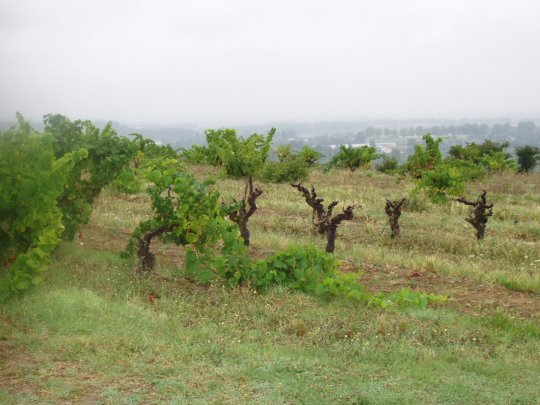Root rot is a parasitic disease caused by fungi, mainly Armillaria mellea, which develops on vine roots and causes the vine to die. The symptoms appear several years after contamination and are difficult to identify.
2.4.2.f Root rot
What damage does root rot cause in the vineyard?
This disease is characterized by:
- A fungal odour
- Waterlogged roots and blackish bark
- White felting under the outer root layers and the crown in advanced cases
- Problems with bud burst
- Yellowing or reddening of the leaves depending on the variety (development of concentric spots)
- Stunted growth, shortening of internodes and atrophied leaves
- An apoplectic form that can affect all or part of the vine
- Clusters of honey-yellow coloured fungi at the base of dead vines
Are there other diseases with which it might it be confused?
Root rot symptoms are quite distinctive: the specific fungal odour, presence of Armillaria mellea carpophores at the base of the vines, and wet and/or waterlogged roots and wood make diagnosis easy. It is seldom confused with other diseases.
The apoplectic form can be due to root rot but also to other causes such as eutypiosis, black foot disease, Esca or BDA, rootstalk strangulation by the graft, very poor pruning, etc. Observations on leaves and wood enable better diagnosis.
What fungi are responsible for root rot and what is their biology?
There are three types of root rot fungi that can attack vine roots:
- Armillaria mellea responsible for "Armillaria root rot"
- Rosellinia necatrix_ responsible for "White root rot"
- Roesleria subterranea_ responsible for "Roesleria root rot"
These three pathogens do not seem to have the same impact on vines. The Armillaria mellea form is responsible for 90% of the cases of root rot contamination. This form survives and feeds on dead wood. Rhizomorphs can grow and contaminate the roots by penetrating the bark. Root rot infections on grapevines are localized and do not seem to spread easily. Contamination could be due to the basidiospores released by the fungi growing at the foot of vines.
Little is known about the life cycle of the other two agents on grapevines, but Roselinia necatrix appears to have a similar cycle to Armillaria mellea.
Are there any preventive measures?
There is no specific curative method for root rot. Only preventive methods can be implemented:
-
Suitability of the environment: when planting a plot, the surrounding environment should be taken into account. For example, planting in close proximity to a forest should be avoided when possible, so as not to favour an overly humid climate. Similarly, before planting, it is advisable to drain or decompact a plot if water stagnates, since root rot fungus is more likely to develop in very humid areas and stagnant water.
-
Preparation and cleaning of the plot: taking into account the previous crop can reduce the risk of contamination. For example, recent uprooting of a contaminated plot, or the former presence of trees and/or dead roots can constitute favourable factors for the establishment of root rot. In such cases, as many of the old roots and dead stumps should be removed as possible. When digging, tools equipped with combs or ripper ploughs (for deep ploughing) can be used to remove most of the roots.
-
Vineyard management: agroforestry is a growing trend in winegrowing. Planting fruit trees or other trees on the edges of plots or within plots must be closely monitored. Poor planting or diseased trees can also lead to contamination by root rot. An outbreak of the disease can then spread to neighbouring vines.

